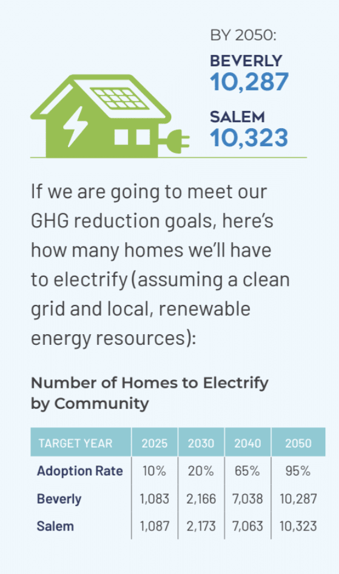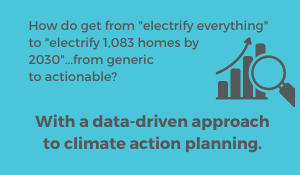Last week the entire KLA Team gathered together in Boston for a team retreat, a focus of which was the importance of our data-driven approach to local government climate action planning. So we asked Kim to share a few key takeaways about the critical role that data plays in accelerating climate action. .jpg?width=559&name=IMG_8996%20(1).jpg)
Why do local governments need a plan? We’re already doing a ton on climate -- can’t we just keep doing it without hitting pause for a plan?
KIM: Yes, you’re already taking action. No, you most definitely should not stop that action for a planning process. But you need a plan to guide you to take the right actions. Think of it as a workplan to help meet your goals. At KLA we design our plans to be super actionable. You won’t solve climate change with a random set of actions – or with setting generic goals like “electrify everything by 2050.” Certainly not at the pace and scope of what’s required in the year 2021 with a critical decade for action.
We have to shift the conversation from WHAT should we do to HOW do we do it.
So taking that “electrify everything” rally cry we hear a lot in climate action circles, you need a plan that goes several layers deep into the highest impact actions – one with technical rigor behind it. You look at the number of municipal buildings vs. commercial vs. residential; new vs. existing structures, heating and cooling sources, etc. Where will you get your biggest bang for the buck? Local governments have various mechanisms available to them including regulatory tools and incentives Utilizing these mechanisms, you can identify actions for each high impact strategy.
You also need to look at a plan – Climate Action Plan, Sustainability Plan, Resilience Plan (we consider “resilience” a combination of mitigation and adaptation), some combo -- as a huge community engagement opportunity. And I’m not just talking about the part where you ask for input to craft a plan. You can do that to a certain extent but should be mindful that most people are not equipped to dive into emissions analysis and goal setting on climate change.
Rather, one of your key community engagement objectives should be to build climate literacy. Ultimately you’ll need everyone to take action to help meet your goals. Done correctly, you can both build your community’s knowledge on climate change and the impacts to them and then provide them opportunities to engage in the planning process. From there, you are in a much better position to guide your community members to take individual action to be part of the solution.
One of the reasons that KLA puts a focus on branding for each of our plans is that we are trying to get to this behavior change, and we know that people will require receiving messages multiple times. That consistent identity and messaging can spark awareness and interest that plays through well past the actual planning process. And remember, you are trying to grab attention of those that are not already taking action, so the message and brand identity that resonates with you personally might not be the best one for engaging that audience.
Your experience developing Climate Action Plans dates back nearly two decades. How has that process evolved over the years and what do you see as the current best practice?
Yes, when I wrote the first climate action plan in Massachusetts for Medford back in 2001, some of the only examples out there were Los Angeles and Portland, Oregon – not exactly our twins.
Of the many differences in the field between now and then, these are three key changes I see:
- Internal vs. External. Back in the day, we didn’t involve many stakeholders or do much community engagement. It was important to show leadership, but it wasn't something in the headlines or on most people's radar screens. So the level of engagement was far lower.
- Data Analysis. In addition to not having much community awareness or concern about climate change, there wasn’t a ton of data available – nor the tools to calculate emissions reductions strategies.
- Peer and Government Support. We benefit from a wealth of state, regional and federal resources today. Even outside of funding opportunities like the Massachusetts Vulnerability Preparedness (MVP) Program, we can tap into so much data from federal agencies like NOAA, FEMA, the EPA and state resources like the Massachusetts Decarbonization Roadmap. The latter, which came out earlier this year, has been a game changer for applying a rigorous data-driven plan, particularly for the smaller communities that might not have access to that data and support otherwise.
So each community is unique and will have their own data points and opportunities, but are you seeing a few key areas that every community must tackle to make good on aggressive climate action goals?
On the adaptation side it’s much more localized because one community might have to deal with sea level rise, another with drought, and so on. The important thing there is to identify adaptation strategies that do not add to emissions.
But on the mitigation side, it’s almost identical. If you’re serious about tackling climate change, you’re looking at electrification, 100% renewable energy, transportation – EVs and reducing vehicle miles traveled (VMT) -- and diverting waste.
Can you share an example of how diving deep into the data from the start can help create better, more targeted goals and a more effective plan overall?

It’s important to note that a GHG inventory is not the only source of data for a climate action plan. Local governments track a ton of data points, and we can use that more effectively than we have in the past. Take assessors reports. You could find out how many commercial property owners there are, how many buildings are over 10,000 square feet, the average age of commercial or residential properties, when roofs were updated, and so on.
All of that information can help you set and meet aggressive, targeted climate action goals.
Use those data points to determine how to incorporate a residential solar, electrification or EV goals*, whether you need to promote heat pumps, if you need a strategy to reach commercial property owners or renters, and so.
*Examples from the recent Resilient Together (Beverly and Salem, MA) plan included here.

For any local governments or consultants out there who want to apply this data-driven approach to their climate/sustainability/resilience plans, what are a few things they should consider?
Focus on the areas with the greatest impact. You don’t need a GHG inventory to know it’s going to be buildings and transportation.
Know the existing programs. What energy efficiency, electric vehicle and other rebates, incentives and programs can you incorporate. If you’ve done your homework on the barriers people face, you can use your plan to address those (for example - where cost is a barrier, those rebates and incentives are critical).
Don’t let the quest for a fully comprehensive plan get in the way of taking action now.


